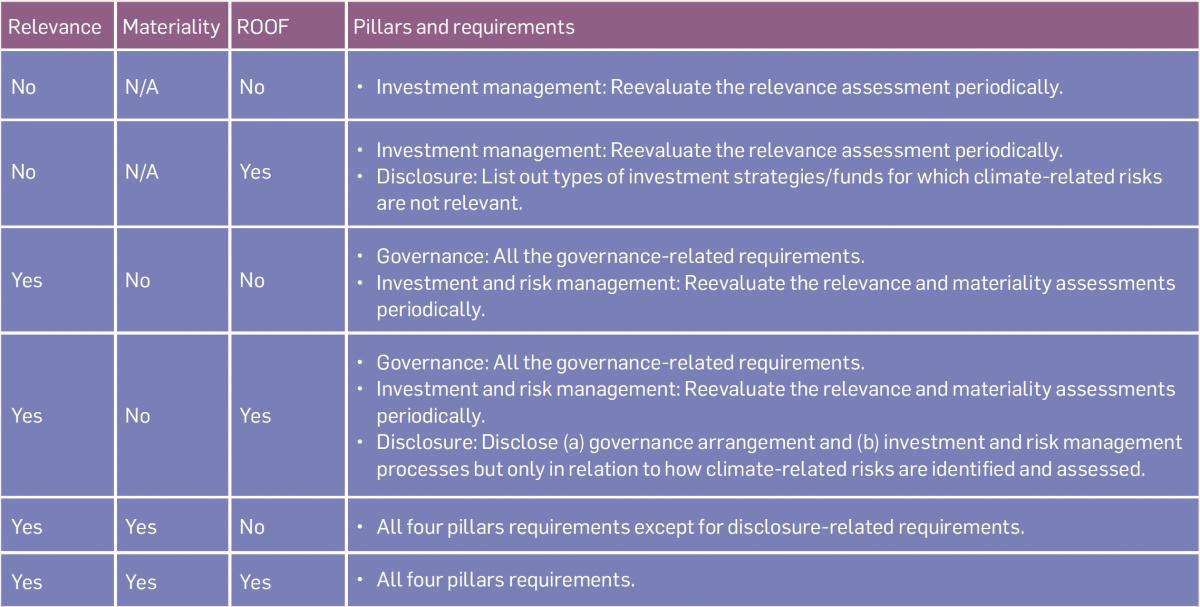On 20 August 2021, the Securities and Futures Commission (SFC) issued the Circular to licensed corporations – Management and disclosure of climate-related risks by fund managers, which sets out the expected standards for complying with the amended Fund Manager Code of Conduct (FMCC). On the same day, the SFC released a set of frequently asked questions to provide further guidance on how fund managers can comply with the amended FMCC. The Consultation Conclusions on the Management and Disclosure of Climate-related Risks by Fund Managers was also released to summarize the feedback from fund managers and the SFC’s corresponding responses regarding the proposed regulatory requirements for managing climate-related risks. In this article, we undertake a review of the climate-related risks regulatory framework and set out a step-by-step guide for fund managers who have less than HK$8 billion assets under management (AUM) on how to assess the applicability of the relevant regulatory requirements; what they should do to ensure compliance; and any potential legal disclosure considerations.
Step 1: Consider if you are “in-scope”
In a nutshell, the new disclosure requirements only apply to managers in Hong Kong who hold a Type 9 (Asset Management) Regulated Activity licence under the Securities and Futures Ordinance and are responsible for the management of “funds.”
In-scope: Fund managers who manage collective investment schemes with investment discretion (fund managers).
Out-scope: Licensed corporations that act as investment advisors or distributors without any investment management discretion.
Step 2: Determine which requirements are applicable if you are “in-scope”
Assuming a fund manager is “in-scope,” the next step is to consider which of the requirements set out by the SFC are applicable to it. The fundamental requirements (also known as the “four pillars”) are focused around (1) governance, (2) investment management, (3) risk management, and (4) disclosure. Depending on the three determinants of (a) relevance of the climate-related risks, (b) materiality of the climate-related risks, and (c) “ROOF” status of the fund manager, meaning whether the fund manager is responsible for the overall operation of the fund (ROOF), Table 1 below will help guide fund managers on which of the four pillars are applicable to them.
Table 1
Step 3: How to determine “relevance” of climate-related risks?
All in-scope fund managers should then identify the following types of climate-related risks and determine whether they are relevant to their funds in Table 2 below.
Table 2
In determining relevance, fund managers may adopt any, or a combination, of the following approaches:
(I) Investment strategies approach
Although the SFC has expressed the view that it will be rare that climate-related risks are not relevant, it accepts that there may be circumstances that such risks are not relevant to certain funds and investment strategies. In that case, fund managers must, after exercising professional judgement, provide justification. Examples of investment strategies for which climate-related risks are likely to be not relevant include day trading strategies, forex strategies, index tracking or managed futures strategies, interest rate strategies, macro strategies and quantitative strategies.
(II) Asset classes
If a fund manager chooses to assess the relevance of climate-related risks by reference to the asset classes in which it invests, asset classes that are likely to be relevant include agricultural assets, commodities, government securities, digital assets (e.g. cryptocurrencies), infrastructure, real estate and single-name issuers’ equity or bonds.
Step 4: How to determine “materiality” of climate-related risks
If climate-related risks have been assessed to be not relevant, there is no need to analyse their materiality. However, if the risks are relevant, fund managers then need to assess the materiality of climate-related risks by adopting an approach which is appropriate and proportionate to their circumstances. When assessing materiality, fund managers may adopt an approach that is (a) qualitative, (b) quantitative or (c) some combination of both.
Fund managers may also set their own percentage thresholds which are deemed appropriate and proportionate to their investment strategies or funds. Nevertheless, such percentage thresholds should be (i) justified to be objectively sensible and (ii) applied on a consistent basis.
In conducting materiality assessment, fund managers should, depending on whether they have similar assets and/or strategies, decide whether the analysis of climate-related risks is required at (a) an investment strategy level, (b) a specific portfolio level, (c) an individual investment level, (d) an overall portfolio level or (e) some or all of the aforementioned levels.
Step 5: Disclosure requirements
If disclosure is required, fund managers should follow the guidelines given by the SFC on disclosure.
Step 6: Maintain records and periodically review the assessments
Regardless of the approach that the fund manager chooses to adopt (and the conclusions that are drawn therefrom), reasons and justifications for methodologies used and any conclusion determined should be properly documented in writing. Internal records of such assessments should also be duly maintained. In addition, such assessments should be reviewed regularly (at least annually) and whenever any major changes occur (e.g. change to a fund’s investment strategy). To reflect the latest assessments, disclosure should also be updated.
Special consideration for fund of funds
For fund of funds, it is unlikely that ROOF managers can take no action at all and completely rely on the risk management measures of the manager of the underlying invested funds. Depending on the circumstances, ROOF managers should take appropriate and proportionate actions and cooperate with the underlying managers to analyse the materiality and relevance of the climate-related risks.
Step 7: Deadline and other practical considerations
Fund managers who have less than HK$8 billion in AUM must comply with the requirements above by 20 November 2022. Last but not least, they should take the following into consideration when assessing and implementing a risk management framework for climate-related risks:
- Detailed records of all documents involved in the assessment of climate-related risks should be duly maintained for compliance review purposes.
- Assessment of climate-related risks and relevant risk management procedures and policies and their disclosures should be reviewed periodically and be updated as appropriate.
- Risk management procedures and policies should be complied with and applied consistently.
- Good corporate stewardship should be built to influence investee companies to implement climate-related risk mitigation measures.
- Management of climate-related risks should involve the board, portfolio managers, investment management team and risk management team, and not only the legal and compliance team.
- The risk management framework for assessing and managing climate-related risks should be proportionate to the circumstances of each fund manager.
This article was contributed by Gaven Cheong, Head of Investment Funds, and Esther Lee, Registered Foreign Lawyer (Counsel-equivalent) at Tiang & Partners, and Loretta Ng CPA, Partner, Climate and Sustainability at PwC Hong Kong.


















